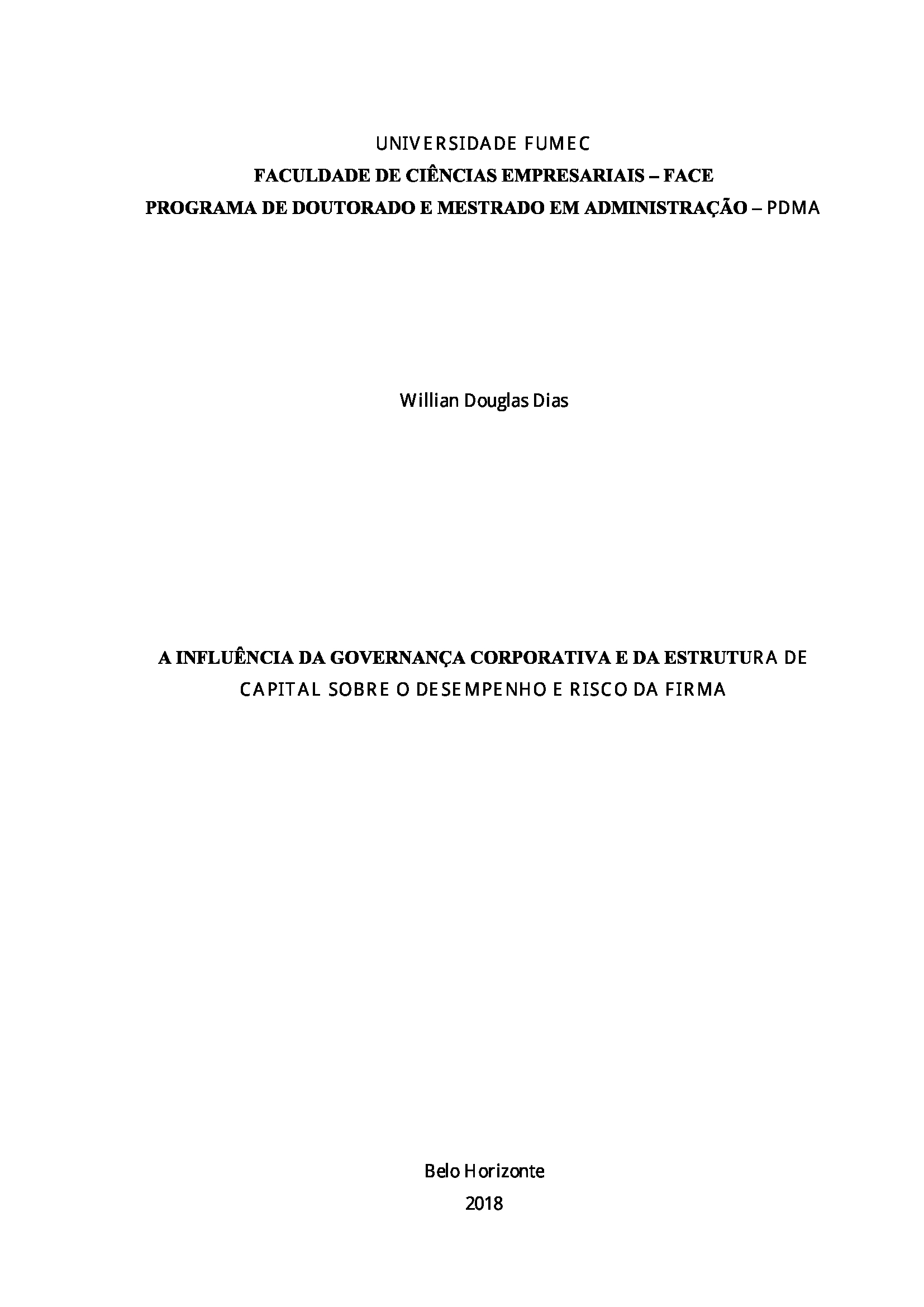A influência da governança corporativa e da estrutura de capital sobre o desempenho e risco da firma

Visualizar/
Data
2018Autor
Dias, Willian Douglas
xmlui.mirage2.itemSummaryView.MetaData
Mostrar registro completoResumo
Esta pesquisa tem como objetivo identificar a influência da utilização das melhores práticas
de governança corporativa e da estrutura de capital sobre o desempenho e risco das firmas
brasileiras de capital aberto, dos setores da indústria manufatureira e eletricidade e água.
Foram estudadas 94 firmas do setor da indústria manufatureira e 43 do setor de eletricidade e
água, no período de 2009 a 2015, selecionadas por serem firmas caracterizadas pelo uso
intensivo de capital fixo. A coleta de dados foi realizada na base de dados Economática® e do
website da B3 (Brasil, Bolsa, Balcão). Como metodologia de mensuração e avaliação das
relações entre governança corporativa, estrutura de capital e desempenho, utilizaram-se as
técnicas estatísticas de regressão múltipla e correlação de Pearson. Para as regressões, como
variáveis dependentes, usaram-se quatro indicadores, três dos quais para a mensuração do
desempenho, a saber: retorno sobre patrimônio líquido (ROE), retorno sobre o ativo total
(ROA) e Q de Tobin; e um quarto foi usado para mensurar o risco, qual seja, a volatilidade
das ações. Como variáveis explicativas, foram utilizados três conjuntos de variáveis, a saber:
o primeiro, composto pelas variáveis de endividamento total e pelos níveis de governança
corporativa da B3 (GC), tratados como dummies; o segundo, composto pelo endividamento de
curto prazo, pelo endividamento de longo prazo e GC; e o terceiro, composto pelas variáveis
de endividamento total em termos simples e quadrático e GC. Assim, totalizaram-se 12
modelos de regressão. O teste de correlação foi realizado entre as variáveis GC e o
endividamento total, de curto prazo e de longo prazo. Identificou-se como resultado que o
modelo de regressão com o endividamento total em termos simples e quadrático é o mais
adequado para explicar a variação do ROE, do ROA, do Q de Tobin e do risco, com base no
R2-Ajustado. Os resultados ainda indicaram que: em um primeiro estágio, à medida que o
endividamento total aumenta, o retorno sobre o patrimônio líquido também cresce, até atingir
o ponto em que o ROE é máximo; e, a partir desse ponto, à medida que o endividamento total
cresce, o ROE diminui; constatações coerentes com a teoria Trade-Off. Tanto o
endividamento total quanto o de curto ou longo prazo influenciam negativamente o ROA e o
Q de Tobin. Em um primeiro estágio, à medida que o endividamento total aumenta, o risco
diminui, até atingir um ponto mínimo; e então, à medida que o endividamento total cresce, o
risco também aumenta. Para as firmas da indústria manufatureira, as boas práticas de
governança corporativa influenciam positivamente a variação do ROA, do Q de Tobin e do
endividamento de longo prazo, e influenciam negativamente o risco e o endividamento de
curto prazo. Para as firmas do setor de eletricidade e água, as boas práticas de governança
corporativa influenciam negativamente o ROE, o ROA, o Q de Tobin e o endividamento total
e de curto prazo. This research aims to identify the influence of the use of the best practices of corporate
governance and capital structure on the performance and risk of Brazilian publicly traded
firms in the manufacturing and electricity and water sectors. A total of 94 firms from the
manufacturing industry and 43 from the electricity and water sector were studied, from 2009
to 2015, selected because they are firms characterized by intensive capital fixed use. Data
collection was done in the Economática® database and the B3 (Brasil, Bolsa, Balcão) website.
As a methodology for measuring and evaluating the relationships between corporate
governance, capital structure and performance, the statistical technique of multiple regression
and Pearson's correlation was used. For the regressions as dependent variables, four indicators
were used, three of which were used to measure performance, namely: (ROE) Return on
Equity; (ROA) Return on Assets, and Q of Tobin; and one of them was used to measure risk,
stock volatility. As explanatory variables, 3 sets of variables were used, namely: the first one,
by the variables of total indebtedness and the levels of corporate governance of B3 (GC),
treated as dummies; the second one, by short-term indebtedness, long-term indebtedness and
CG; and the third one, by the variables of total indebtedness in simple and quadratic terms
and CG. Thus, 12 regression models were aggregated. The correlation test was performed
between GC variables and total, short-term and long-term indebtedness. It was identified as a
result that the regression model with the total indebtedness in a simple and quadratic term is
more adequate to explain the ROE, ROA, Q of Tobin and Risk, because it was the ones that
presented the most of the larger R2-Adjusted. The results also indicated that: in the first stage,
as the total indebtedness increases, the return on shareholders' equity also increases, until
reaching the point where the ROE is maximum, and, from this point, as the total indebtedness
grows, the ROE decreases, coherent with Trade-Off theory. Both total and short-term or longterm
indebtedness negatively influence ROA and Q of Tobin. In the first stage, as total
indebtedness increases, the risk decreases until it reaches a minimum; and then as total
indebtedness grows, so does the risk. For manufacturing firms, good corporate governance
practices positively influence ROA, Q of Tobin and long-term debt, and negatively influence
risk and short-term indebtedness. For firms in the electricity and water sector, good corporate
governance practices negatively influence ROE, ROA, Q of Tobin and total and short-term
indebtedness.
